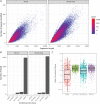Rolling circle reverse transcription enables high fidelity nanopore sequencing of small RNA
- PMID: 36215256
- PMCID: PMC9550094
- DOI: 10.1371/journal.pone.0275471
Rolling circle reverse transcription enables high fidelity nanopore sequencing of small RNA
Abstract
Small RNAs (sRNAs) are an important group of non-coding RNAs that have great potential as diagnostic and prognostic biomarkers for treatment of a wide variety of diseases. The portability and affordability of nanopore sequencing technology makes it ideal for point of care and low resource settings. Currently sRNAs can't be reliably sequenced on the nanopore platform due to the short size of sRNAs and high error rate of the nanopore sequencer. Here, we developed a highly efficient nanopore-based sequencing strategy for sRNAs (SR-Cat-Seq) in which sRNAs are ligated to an adapter, circularized, and undergo rolling circle reverse transcription to generate concatemeric cDNA. After sequencing, the resulting tandem repeat sequences within the individual cDNA can be aligned to generate highly accurate consensus sequences. We compared our sequencing strategy with other sRNA sequencing methods on a short-read sequencing platform and demonstrated that SR-Cat-Seq can obtain low bias and highly accurate sRNA transcriptomes. Therefore, our method could enable nanopore sequencing for sRNA-based diagnostics and other applications.
Conflict of interest statement
New England Biolabs (www.neb.com) has funded this study. SM and SG are employees of New England Biolabs, manufacturer and vendor of molecular biology reagents, including several enzymes and buffers used in this study. New England Biolabs has filed a patent application based on the inventions in this paper. Subjects of this paper may be potential products of New England Biolabs. This does not alter our adherence to PLOS ONE policies on sharing data and/or materials.
Figures





Similar articles
-
High-Fidelity Nanopore Sequencing of Ultra-Short DNA Targets.Anal Chem. 2019 May 21;91(10):6783-6789. doi: 10.1021/acs.analchem.9b00856. Epub 2019 May 10. Anal Chem. 2019. PMID: 31038923 Free PMC article.
-
Transcriptome profiling of mouse samples using nanopore sequencing of cDNA and RNA molecules.Sci Rep. 2019 Oct 17;9(1):14908. doi: 10.1038/s41598-019-51470-9. Sci Rep. 2019. PMID: 31624302 Free PMC article.
-
Improving nanopore read accuracy with the R2C2 method enables the sequencing of highly multiplexed full-length single-cell cDNA.Proc Natl Acad Sci U S A. 2018 Sep 25;115(39):9726-9731. doi: 10.1073/pnas.1806447115. Epub 2018 Sep 10. Proc Natl Acad Sci U S A. 2018. PMID: 30201725 Free PMC article.
-
Untacking small RNA profiling and RNA fragment footprinting: Approaches and challenges in library construction.Wiley Interdiscip Rev RNA. 2024 May-Jun;15(3):e1852. doi: 10.1002/wrna.1852. Wiley Interdiscip Rev RNA. 2024. PMID: 38715192 Review.
-
Beyond sequencing: machine learning algorithms extract biology hidden in Nanopore signal data.Trends Genet. 2022 Mar;38(3):246-257. doi: 10.1016/j.tig.2021.09.001. Epub 2021 Oct 25. Trends Genet. 2022. PMID: 34711425 Review.
Cited by
-
Detecting intragenic trans-splicing events from non-co-linearly spliced junctions by hybrid sequencing.Nucleic Acids Res. 2023 Aug 25;51(15):7777-7797. doi: 10.1093/nar/gkad623. Nucleic Acids Res. 2023. PMID: 37497782 Free PMC article.
-
Induro-RT mediated circRNA-sequencing (IMCR-seq) enables comprehensive profiling of full-length and long circular RNAs from low input total RNA.Nucleic Acids Res. 2024 Jul 22;52(13):e55. doi: 10.1093/nar/gkae465. Nucleic Acids Res. 2024. PMID: 38850158 Free PMC article.
-
High Sensitivity and Specificity Platform to Validate MicroRNA Biomarkers in Cancer and Human Diseases.Noncoding RNA. 2024 Jul 22;10(4):42. doi: 10.3390/ncrna10040042. Noncoding RNA. 2024. PMID: 39051376 Free PMC article.
-
Discrete measurements of RNA polymerase and reverse transcriptase fidelity reveal evolutionary tuning.RNA. 2024 Aug 16;30(9):1246-1258. doi: 10.1261/rna.080002.124. RNA. 2024. PMID: 38942481 Free PMC article.
-
Genome-wide profiling of tRNA modifications by Induro-tRNAseq reveals coordinated changes.Nat Commun. 2025 Jan 26;16(1):1047. doi: 10.1038/s41467-025-56348-1. Nat Commun. 2025. PMID: 39865096 Free PMC article.
References
Publication types
MeSH terms
Substances
LinkOut - more resources
Full Text Sources
Other Literature Sources
Research Materials
Miscellaneous

